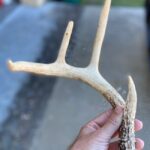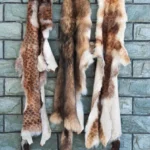At first glance, many species of deer look the same. After all, there are over 40 different species of deer worldwide.
But in this article, I want to talk about the Axis Deer vs Whitetail Deer. Two of the most common and prolific species of deer found in North America.
And only one of them is actually native! Lets dive in…
Table of Contents
- Difference Between Axis Deer vs Whitetail Deer
- Appearance Differences Between Axis And Whitetail Deer
- Differences Between Axis And Whitetail Meat
- Which Is More Popular For Hunting, Axis Or Whitetail?
- FAQs
- Conclusion
- Related Posts
Difference Between Axis Deer vs Whitetail Deer
The main difference between Axis Deer and Whitetail Deer is their native habitat. Whitetail Deer are native to North America, and highly adaptable to a variety of environments. Axis Deer are native to India, but have been introduced to North America on private game ranches for hunting purposes.
Lets take a deep look into the differences…

Habitat And Range Of Whitetail And Axis Deer
Axis deer have the smaller range of the two species. Originally from India and Sri Lanka, Axis deer have been introduced as a non-native species, predominantly in Southern Texas and Hawaii with smaller populations in California and Florida.
For hunters, they offer an additional species of deer that can be hunted year round.
Whitetail deer, which are native to North America, are found all across Southern Canada and most of the U.S. except for a few southwest states and Alaska and Hawaii and closely regulated by deer hunting seasons.
Axis Deer Habitat
Axis deer are far less adaptable than whitetail and this is evident in their habitat. Axis live in grasslands, savannas, and at the edge of forests. They are not sure-footed and therefore prefer flat ground.
Also, due to the large size of the bucks’ antlers, they prefer sparse forests as their antlers get entangled in the vegetation of denser forests.
Whitetail Habitat
Whitetail deer are highly adaptable and prefer a habitat that’s a mixture of hardwoods, croplands, brushlands, and pastures. They are preferential to a habitat interspersed with meadows.
Given that their range is all over the U.S., they can encounter harsh winters and need thick forests to keep them warm during the winter months.
Whitetail vs Axis Deer Size
Overall, Whitetail deer are the larger species by weight, reaching up to 300 pounds. However axis deer are taller, standing on average 4 inches taller than the whitetail at shoulder height.
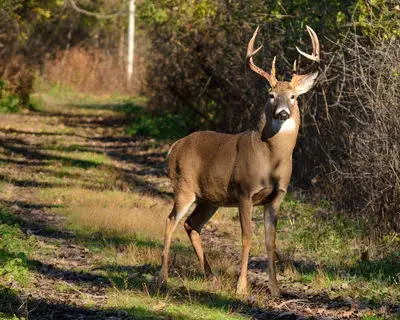
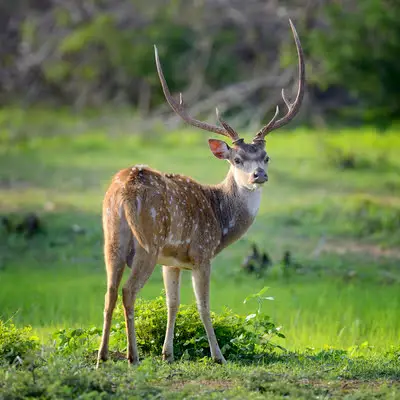
Axis bucks weigh in at 145-250 pounds while whitetail bucks average 100-300 pounds.
Whitetail does start at a little under 100 pounds and go up to 200 pounds. Axis does weigh about 90-150 pounds.
Appearance Differences Between Axis And Whitetail Deer
Axis Deer Coloring And Antlers
The biggest difference in appearance between the axis and whitetail species is the characteristic white spots of the axis deer, and the taller and longer antler growth.
Whitetail fawns have white spots at birth, but they disappear as the fawn grows. Axis deer keep their spots for life. The spots start at the neck and run the length of the deer continuing down the legs.
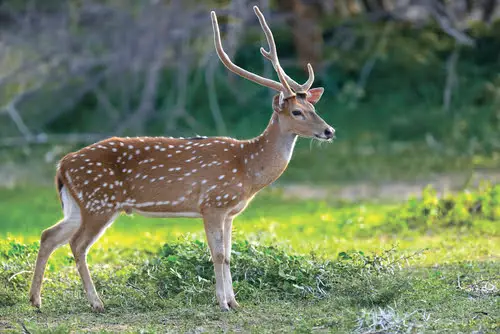
The base coat color is a light brown with the underside being a cream or white color.
Axis deer also have an identifying white patch on their neck as well as a dark stripe running down the backbone from the neck to the tip of the tail.
The antlers of an axis buck usually have 6 points and grow upward, not outward.
Whitetail Deer Coloring And Antlers
The coats of whitetails are interesting in that they change color in different seasons. In the summer the whitetail’s coloring is a reddish-brown that then turns to a grayish-brown in winter to provide better camouflage in the bare forest.

Distinctive markings include the characteristic white underside of the tail from which the whitetail derives its name. They also have white on the throat like an axis deer, but they have additional white areas around the eyes and nose. The underside is also white.
Feeding Habits
Both whitetail and axis deer are herbivores and both eat forbs and browse for food. The big difference with food is that axis deer can eat grass which they will graze on if they can’t get enough food from forbs or browsing.
Whitetails cannot process grass and will die from malnutrition if they try to sustain themselves with it. They are also more selective about their food sources than axis deer are.
Behaviors of Axis vs Whitetail Deer
Whitetail deer are known for being very solitary. The only social groups they form are either with their fawns or temporary herds that form while they feed. While whitetails do use some vocalizations like blowing and grunting to communicate, it is far less than those of the axis deer.

The rut or mating season for whitetail deer is from mid-October to early December whereas axis deer rut in the middle of summer during June and July.
Axis deer are known to behave very similarly to elk. They are highly sociable and it is common for a buck to have a harem of does. They stay in herds of 6-30 deer.
They are also very vocal like elk. Some of their vocalizations include bellows and alarm barks. Bucks have also been known to roar like elks.
Differences Between Axis And Whitetail Meat
While the meat from both species is classified as venison, there are some big differences in taste and texture.
Whitetail
The less popular of the two is by far whitetail. It is known to have a light, “gamey” flavor and to leave a waxy feeling in your mouth. The waxy feeling is due to the fat content of whitetail and can be reduced by trimming any excess fat off the meat during processing.
Not only is it gamey, but depending on the cut and preparation of the meat, it can be tough and require some hardy chewing to get through it…that is why it’s very important to eat venison medium rare, and not to overcook it.
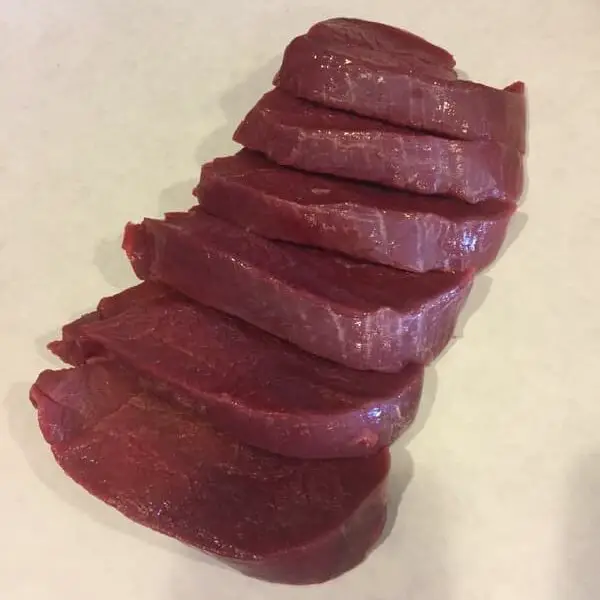
Axis
The meat of axis deer has a much deeper mahogany color than whitetail meat. It is also considerably leaner with only 0.2 percent fat. It is one of the leanest types of meat.
Fat is one of the key things that lead to a “gamey” flavor, so the leanness gives the axis a very mild flavor that is far less “gamey” than whitetail meat.
Axis is also known for being extremely tender. The silverskin is not as tough or chewy as it is on whitetail. The fat of axis deer also cooks better than that of whitetail and doesn’t leave a waxy mouthfeel after consuming it.
Due to the tenderness, lack of a “gamey” taste, and leanness, axis deer makes a great substitute for beef.
Overall, axis deer is considered the best game meat available other than elk.
You May Also Like: Mule Deer vs Whitetail Taste Differences, Explained!
Which Is More Popular For Hunting, Axis Or Whitetail?
Both axis and whitetail are great species of deer to hunt, and they each offer their own unique benefits and draws.
Hunting Axis Deer
The biggest attraction of hunting axis deer is that, because they were imported to Texas in the 1930’s, they are classified as an exotic species and you are allowed to hunt them year-round.
They are also highly desired for their meat as previously mentioned. Unfortunately, they have a very limited range that is not accessible to a lot of hunters.
If you’re lucky enough to be in an area where they live though, you have access to a great species and some tasty meat!
Hunting Whitetail Deer
Whitetail deer is the most popular hunted game species in the United States. A big reason for this is because of their wide range and large numbers. Whitetail is found in almost every state aside from a few western states.
Unfortunately, whitetails can only be hunted when they are in season.
While their meat can be “gamey” and a little tough, it’s easy to mitigate this by trimming excess fat during processing and then preparing and cooking it properly.
Hunters often mix their venison with pork to add a fatty flavor and blend it for tasty burgers and sausage.
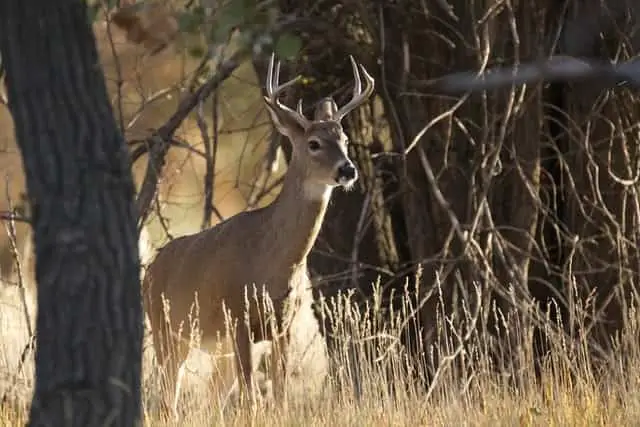
FAQs
Do Axis And Whitetail Deer Crossbreed?
Whitetail and axis deer don’t crossbreed. Even if they did crossbreed, no viable offspring would be produced.
How Long Do Axis Deer Keep Their Antlers?
Unlike whitetail deer who only shed their antlers in the winter, axis deer can shed their antlers anytime.
Do Whitetail Deer Compete With Axis Deer?
Yes, both species of deer compete with one another. The axis deer will survive due to its ability to eat grass.
Due to the whitetail’s inability to extract nutrients from grass, they will die from malnutrition if there are not enough forbs or food available through browsing to sustain them.
Conclusion
Axis and whitetail are both excellent species of deer with a lot to offer. Axis deer are highly valued and hunted year-round on private ranches for their tender, mild-flavored meat.
Whitetails offer a sustainable food source and are an easily accessible game species for most hunters.especially in the mid west, eastern and southern United States.
Thanks for reading!

